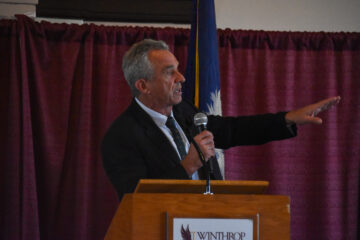Most of us have been told or at least presented with the idea at some point in our lives that in order to be taken seriously, we must speak the right way. But who is determining what is actually considered correct?
In 1927, when anthropologist and author Zora Neale Hurston tracked down Cudjo Lewis, the only survivor living at the time who was brought to America on the last slave ship, she interviewed him with the goal of publishing a book about his experiences. Unfortunately, she was unable to publish the book because publishers wanted her to write what he said in what they deemed as the right way of speaking.
Hurston aimed to preserve his dialect by writing out the interview exactly how he spoke. If she had not done this, there would be no record of his dialect, much less an interview with him at all. It wasn’t until May of 2018 that the interviews were finally published in the book “Barracoon: The Story of the Last ‘Black Cargo’,” edited by Deborah G. Plant.
Recently this semester in Dr. Kelly Richardson’s Grammar in Theory and Practice class (ENGL 530-001), students were given a Ted Talk to watch about the issue of correctness in grammar, with the assignment of giving their thoughts in a discussion board. In the Ted Talk, a linguistics professor at the University of Kansas, Phil Duncan, shared his research and understanding about the English language and arguments people often make as to why they believe certain things are simply right or wrong when it comes to grammar.
Duncan shared the most common arguments and assumptions, such as not being able to understand what a person is saying when using double negatives and sounding out letters in words that are supposed to be silent. For the first one, he brought up the point that there are countless songs which include double negatives, “ain’t no sunshine when she’s gone,” being one of the most popular lyrics.
If songs like this are commonly sung, there is obviously no confusion in understanding a double-negative sentence. For the other argument, he reveals that although silent letters may exist today, for the word “ask,” the version “axe” is in actuality “the historical version that predates ‘ask.’”
It is important to realize that, just like with Lewis’ dialect, those who are the majority often use language as a way to superiorize themselves while discriminating against those who are outside of their own culture. Although this is all too often being done today, it comes from a colonialist mindset that views other dialects and usages of words as being incorrect. This is similar to the way islanders were forced to adopt a British-sounding accent due to being invaded by Europeans, as well as how many of our founding fathers, such as Thomas Jefferson, often referred to Native Americans as “savages.”
While language discrimination is distributed widely to all races, nationalities and backgrounds, people of color are intensely pressured by society to extinguish anything about their speech, writing or voice that may be viewed as “ghetto” or “urban.” People of color should not have to feel like they need to sound white during a job interview, shopping for a car or housing, or when making phone calls whether professional or personal.
Very rarely do white people ever question country music artists’ usage of words such as, “ain’t,” “nothin’,” “no more” or any other slang phrases that are considered improper. Yet, many are accustomed to criticizing black rappers and other artists for using those same exact words.
This idea of what is “proper” grammar or the “right” way of speaking is continuing to affect society in a negative and destructive way. We are now faced with the predicament of being stuck in what is considered standard based on generations of inequality while attempting to stop language discrimination and increase linguistic diversity when it seems society is going against it.
Until we push ourselves outside of our boxes and try to find the truths that have been buried under years of biases, stereotypes and imperialism, the issue of inequality and need for equity goes on further.
Graphic by Katelyn Miller



